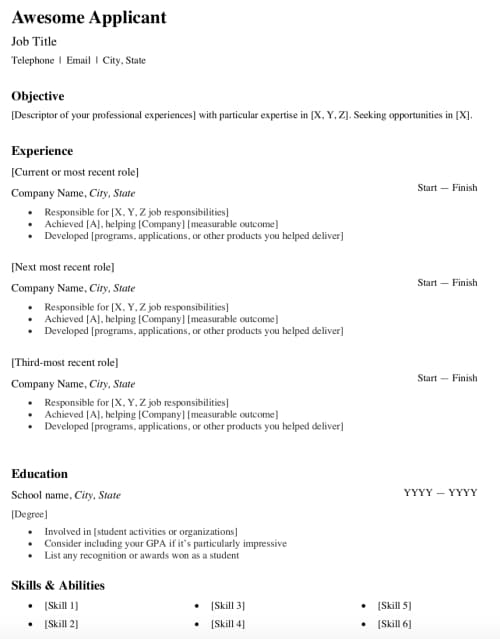The Only Chronological Template You Need to Land Your Dream Job
Whether you're writing your first resume or simply updating your resume for a new job search, it's important to ensure that it presents your experiences in the best possible light. For many — if not most — job applicants, a chronological resume is the best option. This format helps a recruiter or reviewer understand an applicant's work experiences as quickly as possible when they pick their resume up. Since a 2017 Jobvite survey found that 92% of recruiters see previous job experience as the number one hiring factor, this is extremely important. To learn how to craft a chronological resume, read on.
What is a chronological resume?
A chronological resume, or reverse-chronological resume, is a resume that lists your professional experiences in descending order from most to least recent. It puts your professional experiences on top, ahead of education, skills and any additional sections you may see fit to include.
What are the advantages and disadvantages of a chronological resume?
In comparison to other resume types, a chronological resume has two main advantages. First and most importantly, it puts your experiences and achievements front and center, emphasizing these as the most important part of your professional profile. It's also easy to scan, which is important for time-crunched resume reviewers who are inundated by applications.
However, it's also important to note that the chronological resume template has some drawbacks as well. First, it demands consistent formatting — in this type of resume, inconsistencies in how you list professional experiences, for example, are easily spotted. Second, a chronological resume exposes gaps in employment, which may be a challenge for people who've taken time off work for personal reasons or have been on the job market for a relatively long time between jobs.
Who should use a chronological resume?
The short answer is essentially everyone. Because this format is favored by recruiters, it's a safe bet. If you're looking to highlight your skills and experience, you should use a chronological resume.
Is a chronological resume better than a functional resume?
As already discussed, a chronological resume is the best choice for most people. However, those with scattered work histories, a number of employment gaps or a series of short-term jobs may want to consider the functional resume format instead of the chronological resume format to help blur over those issues.
A functional resume, also referred to as a skills-based resume, highlights skills and expertise over work history. This format is recommended for career changers, people with employment gaps or jobseekers targeting roles that aren't directly related to their existing professional experience. However, it's important to consider that a functional resume is a bit harder for resume reviewers to follow in comparison with a chronological resume — so this alternative format should be used relatively infrequently.
If you don't fall into the special situations that warrant a functional resume, you should stick with a chronological resume.
How to create a chronological resume
Before you start creating a resume, it's helpful to ensure that you have all the information you need to include on it. Personally, I like to start by simply writing out some notes for each professional experience, educational experience and skill that I'm planning to include.
Then, you should look for a good template. Both Microsoft Word and Pages have pre-loaded resume templates, and you can also find good templates online via an easy Google search. Whatever template you choose, make sure it's easy to work with, customizable and easy to read. To this end, avoid overly elaborate fonts, too-small font and poorly delineated sections.
As you write your chronological resume, you'll want to ensure the following sections are included in this order:
- Name and job title
- Contact information
- Resume summary or objective
- Professional experience in reverse chronological order
- Education
- Skills
- Additional sections, if applicable
Chronological resume template.
As you put a chronological resume together, there are a few key specific pieces of information that need to be included in each section.
Name and job title.
This should be self-explanatory. Your full name should be at the top of your resume, and your current job title should be on the line below it.
Contact information.
Your resume should include your phone number, email address (be sure to use a professional one) and current location (city and state will do).
Resume summary or objective.
One or two sentences at the top of your resume will help resume reviewers understand who you are very quickly. They're also a good way to quickly frame your experiences thus far, which is helpful for summarizing multiple job experiences and tieing them together into a single cohesive narrative.
Professional experience.
This is the focus of a chronological resume, and should take up the most page real estate. You should list your work experiences in descending order (with the current or most recent first) and include a few bullet points or sentences describing your responsibilities at each company. Be sure to include specific achievements to illustrate the value you bring to your employer.
Education.
In this section, you'll want to include your school's name and location as well as the degree you earned while attending it. If you have multiple degrees, you should list these in reverse chronological order as well, with the most recently earned degree first. As with professional experiences, you should include a few bullets or sentences on notable activities you were involved in and recognition that you earned while in school.
Skills.
Putting key relevant skills on your resume helps a prospective employer understand what you're capable of doing on day one. Bullet points are the most efficient way to convey skills. Use a reasonable organization method for your skills, such as rough categories (hard skills, soft skills and language skills), alphabetical order or proficiency level (advanced, intermediate or beginner/basic).
To see how this would look put together, refer to the following generic template:

Don’t miss out on articles like these. Sign up!
Lorelei Yang is a New York-based consultant and freelance writer/researcher. Find her on Twitter and LinkedIn.
Why women love us:
- Daily articles on career topics
- Jobs at companies dedicated to hiring more women
- Advice and support from an authentic community
- Events that help you level up in your career
- Free membership, always
